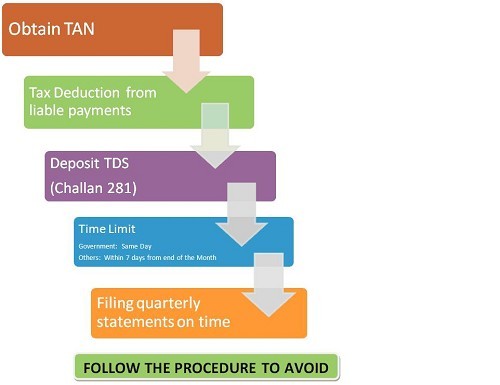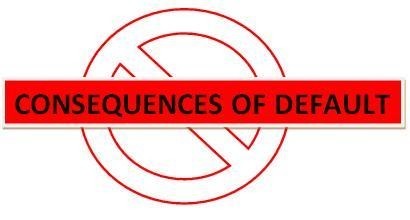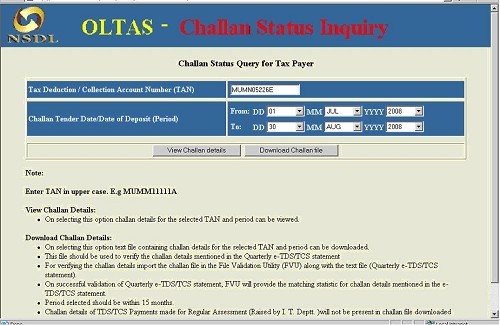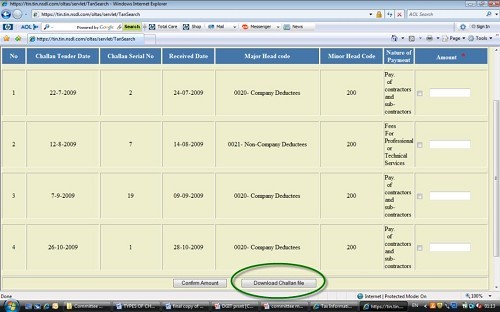Overview of TDS
?
?
TDS is one of the modes of collection of taxes, by which a certain percentage of amounts are deducted by a person at the time of making/crediting certain specific nature of payment to the other person and deducted amount is remitted to the Government account. It is similar to "pay as you earn" scheme also known as Withholding Tax in many other countries, one of the countries is USA. The concept of TDS envisages the principle of "pay as you earn". It facilitates sharing of responsibility of tax collection between the deductor and the?tax administration. It ensures regular inflow of cash resources to the Government. It acts as a powerful instrument to prevent tax evasion as well as expands the tax net.
�ives of TDS
Tax Deducted at Source was introduced in India to facilitate the payment of tax while receiving the income and it follows the concept of ?Pay as you earn?. However, the?purposes of tax deducted at source is?changing slowly. Now, the �ives of tax deducted at source are:
??To enable the salaried people to pay the tax as they earn every month. This helps the salaried persons in paying the tax in easy instalments and avoids the burden of a lump sum payment.
??To collect the tax at the time of payment of income to various assessees such as contractors, professionals etc.
??Government requires funds throughout the year. Hence, advance tax and tax deducted at source help the government to get funds throughout the year and run the government smoothly.
??It helps to spread the tax net wide enough to include persons who might otherwise have evaded taxes. The minimum thresholds are raised and the rates are reasonable and comparable with the rates prevailing in other countries. Hence, it is very vital to make all the persons earning the taxable income pay the tax. But, the best way to make them pay is to deduct tax at source.
Who shall deduct tax at source?
Every person responsible for making payment of nature covered by TDS provisions of Income Tax Act shall be responsible to deduct tax.
However in case of payments made under sec. 194A, 194C, 194H, 194I and 194J in respect of individual and HUF, only if the turnover or professional receipt exceeds sum of Rs. 40 lakh or Rs. 10 lakh respectively (the limits will be Rs.60 Lakh or Rs. 15 Lakh respectively w.e.f. 01.04.2010) in previous year, he is required to deduct tax at source.
These persons are mainly:
- Principal Officer of a company for TDS purpose including the employer in case of private employment or an employee making payment on behalf of the employer.
- DDO (Drawing & Disbursing Officer), In case of Govt. Office any officer designated as such.
- In the case of "interest on securities" other than payments made by or on behalf of the Central govt. or the State Government, it is the local authority, corporation or company, including the Principal Officer thereof.
Such person is called?Deductor?while the person from whom the tax is deducted is called?Deductee.
Tax must be deducted at the time of payment in cash or cheque or credit to the payee's account whichever is earlier. Credit to payable account or suspense account is also considered to be credit to payee's account and TDS must be made at the time of such credit.
?
What a deductor must do?
1.?Obtain TAN
Every deductor is required to obtain a unique identification number called TAN (Tax Deduction Account Number) which is a ten digit alpha numeric number e.g.DELH90468K.
This number has to be quoted by the deductor in every correspondence related to Income Tax matters concerning TDS.
2.?He/She should obtain PAN of the deductee.
3.?He/She should deduct the tax at correct rate.
?????For Rates see:??TDS/ TCS Rate Chart Fy 10-11
4.?The tax deducted has to be deposited in the designated banks within specified time.?(Govt. deductors shall transfer the tax deducted through book entry in Government account).This is detailed below:
?By or on behalf of the Government? :?on the same day,
?By or on behalf of any other person :?On or?before the 7th?of the following month.
However, for the month of march the tax should be remitted by 30th?April.
(Prior to FY 10-11,?if the amount is credited in the books on 31st?March then the tax had to be remitted by 31st?May and if TDS deducted on payment on 31st?March due date remained 7th?April)
Note: w.e.f., 01.04.2008?electronic payment?of tax has to be done by?all corporate assesses?and all persons whose cases are auditable under section 44AB.
5.?Use challan no. 281 for depositing TDS amount.
6.?File statements of tax deduction in the prescribed time.
The due dates for filing of TDS/TCS statement are :
15th?of July?for?Quarter 1,
15th?of October?for?Quarter 2,
15th?of January?for?Quarter 3?and
15th?May for last Quarter?however for TCS statements (Form 27EQ) the due date is?30th?April.
7.?Use correct form to file TDS/TCS Returns. They are:
Form 24Q???? for salaries
Form 26Q ??? for non salaries
Form 27Q????For Non Resident (TDS deducted u/s 195)?
Form 27EQ??? for TCS
Form 27A/27B Control sheet for electronic TDS/TCS
It may be noted that the following persons have to compulsorily file e-TDS /e-TCS statements
- All government offices/Departments
- All companies /corporations
- All persons whose cases are auditable
- All persons whose TDS statements contain more than 50 deductees.
Dos & Dont's for filing TDS Returns
Dos
- Ensure that TDS return is filed with same TAN against which TDS payment has been made & TDS certificate is issued.
- Ensure that correct challan particulars including CIN and amount is mentioned.
- Correct PAN of the deductee is mentioned.
- Correct section is quoted against each deductee record.
- Correct rate is quoted against each deductee record.
- File correction statement as soon as discrepancy is noticed
- Retain the original FVU file to enable future corrections
- Make use of free of charge RPU provided through TIN-NSDL.com
- Download details of challan from challan status enquiry (TAN based view) from TIN-NSDL.com
- Registration for TAN enables you to avail additional facilities from Tax Information System.
- Always verify status of TDS returns from Tin NSDL to ascertain the discrepancy, if any, and/or whether your TDS return stands accepted or rejected by the system.
- Mention the details of Transporter in your Return and maintain the records of Transporter and obtain a copy of their PAN card.
- Deduct TDS @ 20% if PAN not provided by Deductee (U/s 206AA)
Dont's
- Don't file late returns as it affects deductee tax credit.
- Don't quote incorrect TAN vis-?-vis TDS payments.
- Don not late deposit TDS as it attracts penal interest (Raised from 1% to 1.5% per annum w.e.f. 01.07.2010) as well as penalty us/ 221.
- Do not quote incorrect PAN.
?
8.?Issue TDS certificates?as per procedure and within the time prescribed as stated below:
|
Sl. No. |
Category |
Periodicity of furnishing TDS certificate |
Due date |
|
1 |
Salary??? (Form No.16) |
Annual |
By 31st?day of May of the financial year immediately following the financial year in which the income was paid and tax deducted |
|
2 |
Non-Salary (Form No.16A) |
Quarterly |
Within fifteen days from the due date for furnishing the ?statement of TDS? |
Procedure:?


TDS defaults
Failure to deduct the whole or part of the Tax at source (non-deduction, short deduction or delay in deduction)
1. Failure to deposit whole or part of the TDS (non-deposit, short deposit or late deposit)
2. Failure to apply for TAN within the prescribed time limit or failure to quote TAN on allotment as required under section 203A.
3. Failure to furnish, in due time, TDS returns or TDS certificates or to deliver or cause to be delivered a copy of declaration in form no. 15H/15G/27C/copy of quarterly statement.
4. Failure to mention the PAN of the deductee in all quarterly statements as well as in all certificates furnished.
Consequences of Defaults
The following chart indicates the nature of default and its consequences which range from?penal interest, penalty to prosecution:
|
Default/ Failure |
Under section |
Nature of demand |
Quantum of demand/penalty |
|
Failure to deduct tax at source |
201(1) |
Tax demand |
Equal to tax amount deductible but not deducted |
|
201(1A) |
Interest |
@ 1% p.m. of tax deductible |
|
|
271C |
Penalty |
Equal to amount of tax deductible but not deducted |
|
|
Failure to deposit tax deducted at source |
201(1) |
Tax demand |
Equal to tax amount not deposited |
|
201(1A) |
Interest |
@1.5% p.m. of tax not deposited
|
|
|
276B |
Prosecution |
Rigorous imprisonment for a term which shall not be less than 3 months but which may extend to 7 years and with fine 3 months but which may extend to 7 years and with fine. |
|
|
Failure to apply for tax deduction account number (TAN) u/sec. 203A |
272BB |
Penalty |
Rs. 10000/- |
|
Failure to furnish prescribed statements u/sec. 200(3) |
272A(2)(k) |
Penalty |
Rs. 100 for every day during which the failure continues shall be levied subject to the maximum of TDS amount. |
|
Failure to deliver copy of declaration u/sec. 197A |
272A(2)(f) |
Penalty |
Rs. 100 for every day during which the failure continues shall be levied subject to the maximum of TDS amount. |
|
Failure to issue TDS Certificate u/sec 203 |
272A(2)(g) |
Penalty |
Rs. 100 for every day during which the failure continues shall be levied subject to the maximum of TDS amount. |
|
Failure to furnish statement of perquisite or profit in lieu of salary u/sec. 192(2C) |
272A(2)(i) |
Penalty |
Rs. 100 for every day during which the failure continues shall be levied subject to the maximum of TDS amount. |
|
Failure to mention PAN of the deductee in the TDS statements and certificates |
272B |
Penalty |
Rs. 10000/- |
In addition to the above, there are?other?consequences in certain cases, as enumerated below;
?? Disallowance of specified expenditure (while computing the income of the deductor) if TDS is not deducted from the payment. (Section 40a(ia)).
?? Where the tax has not been paid after its deduction it shall be charge on the asset of the defaulter to recover the amount of TDS. (section 201(2)).?
???Disallowance of specified expenditure where tax has been deducted but not paid before the due date of filing return of income.
Non deduction or deduction at lower rate in certain situations
No Tax has to be deducted for the payment made to Government, RBI, Corporation whose income is exempt from tax or mutual fund specified u/sec. 10(23D). Also in case where deductee produces a non deduction certificate or lower deduction certificate u/sec. 197 of the Income Tax Act 1961.
Self declaration in Forms 15G and 15H can be filed by the deductee if his income doesn't exceed the amount chargeable to tax. This self declaration can be filed for dividends, interest and mutual fund income only. In these cases no tax has to be deducted.
Dos and Dont's for Depositing Tax
Dos
- Use?challan type 281?for deposit of TDS/TCS amount.
- Deductor should quote?correct TAN, full name, address?and current A.Y.?on each challan.
- Deductor should use?separate challan?for?different nature of payments?quoting correct nature of payment code and also for different type of deductee.
- Ensure that the bank has mentioned?CIN?(Challan Identification Number) on the counter foil.?Verify CIN details?uploaded by the bank to TIN i.e., 5 digit challan serial no., BSR code of 7 digit and date.
- Insist on computerized receipts from the bank
- E- payment of TDS is recommended. (As in case of lost challan Duplicate copy can be easily printed from bank website by loging in with your ID and password)
All details of the payment as uploaded by the banks are available at the NSDL- TIN website www.tin-nsdl.com under the link "challans status enquiry".? Deductor should verify the details for ensuring the credit for payments.
Through the?TAN Based View?details of all challans deposited in the
banks for a given TAN during a specified period can be viewed.


(The challan data file can also be downloaded for verification of challan data entered at the time of preparation of e-TDS returns.)
Dont's
- Don't use?incorrect type of challan
- Don't quote?wrong TAN?or use PAN in place of TAN or vice versa.
- Don't use a?single challan?for corporate and non-corporate deductees.
- If one has multiple TANs,?use one TAN only?consistently and surrender the others.
- Don't use preprinted challans?without verifying TAN/PAN.
- Each branch/division of an entity will have a separate TAN if it is filing separate TDS/TCS returns.? However, there will be only one PAN for a legal entity.
- Do not make mistake in indicating the?Assessment Year?in the challan.
TAX COLLECTED AT SOURCE (TCS)
What is TCS?
he?seller?has to collect tax?from the payer?who has purchased the following items :
- Alcoholic liquor for human consumption
- Tendu leaves
- Timber obtained under a forest lease
- Timber obtained by any mode other than under a forest lease
- Any other forest produce not being timber or tendu leaves
- Scrap
- Parking lot
- Toll plaza
- Mining and quarrying
The TCS on the above mentioned items?vary from 1% to 5%
Who is Seller?:
following persons are covered under the scope of the seller for TCS purpose
- The Central And State Government.
- Local authority
- Statutory corporation or Authority
- Company
- Firm
- Co-operative society
- Individual or Hindu undivided family(HUF) if covered under section 44AB (mandatory Audit)
Who is Buyer?
- Buyer Means a person who obtains in any sale, by way of auction, tender or any other mode, specified goods ,or right to receive any such goods
- but does not include:
- Public sector company,
- Central/state Government,
- Embassy, a high commission, legation, consulate and the trade representation of a foreign state and
- A club
- A buyer in the retail sale of such goods purchased for personal consumption
So goods purchased by consumers are not covered under TCS
?
When tax has to be collected?
- Tax (TCS) has to be collected at the time of debiting of the amount payable to buyer or at the time of receipt of payment, whichever is earlier.
The rates of TCS for representative purpose (Financial Year 2010-11):
?
|
Collection Code |
Nature of Purchase |
Tax?(?o) |
|
6CA |
Alcoholic liquor for human consumption |
1 |
|
6CB |
Timber obtained under a forest lease |
2.5 |
|
6CC |
Timber obtained under any mode other than forest lease |
2.5 |
|
6CD |
Any other forest product not being timber or tendu leave |
2.5 |
|
6CE |
Scrap |
1 |
|
6CF |
Parking Lot |
2 |
|
6CG |
Toll plaza |
2 |
|
6CH |
Mininci and quarrying |
2 |
|
6CI |
Tendu leaves |
5 |
|
Surcharge (On Tax) |
Applicable for Foreign Companies if collections exceeds Rs.1 crore of such companies |
2.5 |
|
Education Cess (on Tax) |
Applicable for Foreign Companies |
3 |
*Pay Tax (Timely), Karo Relax.....
My other useful TDS related posts:
Transporter details in TDS return FAQ....
Regards
CMA. Sanjay Gupta








 CAclubindia
CAclubindia
